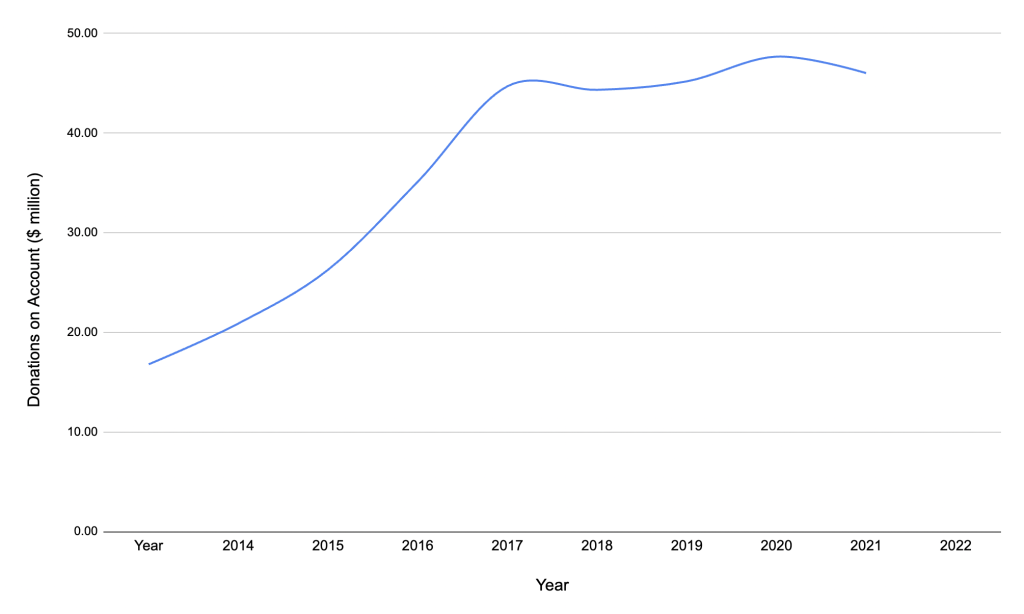In the United States, due to it’s IRS tax exempt status Scientology’s finances are somewhat protected from public scrutiny. Fortunately for us, the same is not the case in the UK, where Scientology operates through an Australian-registered charity called Church of Scientology Religious Education College Inc (or COSRECI).
Under Australian law, charities registered with the ACNC (Australian Charities & Not-for-profits Commission) are required to submit an annual financial report – and for organisations with a turnover of over $1 million AUS, they must be incredibly detailed and audited by a third party. In 2022, COSRECI reported an annual revenue of $26,562,014 AUS ($18,327,789 USD or £13,688,601 GBP) which means they are well over this threshold.
COSRECI’s financial reports are public record and available to access for free online through the ACNC website. For the purposes of this article, we have converted COSRECI’s figures into US Dollars using a rough currency conversion based on the average AUD to USD conversion rate each year.
Gross Revenue
First up, we have gross revenue. This figure accounts for the total amount of money received by COSRECI, which includes donations, course fees and book sales at their East Grinstead headquarters Saint Hill, London Org and Birmingham. Over a course of 3 years, COSRECI’s income almost tripled, from $13.1 million in 2013 to $35.4 million in 2016. However, since then Scientology has very clearly been in decline, with the most recent (2022) report showing an annual revenue figure of $18.3 million.

Staff Allowances
Another interesting figure to look at is staff allowances. Members of Scientology’s management organisation are called the ‘Sea Org’ and are expected to sign one-billion year contracts, committing their life to the Church. They work gruelling hours, 7 days a week and in return for their hard work are given accommodation, food and a weekly stipend of $50. It is important to note COSRECI’s filings also include Class V staff, who work in the city-level Churches such as London or Birmingham. These staff members sign much shorter 2.5 or 5 year contracts and are paid a percentage of their Org’s weekly turnover. If an Org’s income falls one week, staff often receive little or no pay. For context, during my time on staff at London Org in 2013/2014 I was paid an average of £20 ($26 USD) per week.
It’s not possible to establish from COSRECI’s filings with the ACNC whether the decline in amount spent on staff allowances was due to falling stats, or people leaving staff, but the numbers reveal a sharp decline nonetheless, falling by more than 50% from 2018 to 2019.
Could the fall in staff allowances be an indicator Scientology lost half of its UK staff as a result of the Leah Remini & the Aftermath show, which aired its final season 2018-2019?

Undelivered Services
Perhaps one of the most worrying figures for COSRECI’s finances is it’s contingent liability, or ‘money on account’. Scientologists regularly get ‘regged’ to pay for services in advance and are sold auditing in packages known as ‘intensives’, where discounts are offered when buying in bulk.
It is well documented that Scientology don’t offer refunds. Mike Rinder explains the policy on his blog, but in summary the Church places a condition that upon requesting a refund, a Scientologist may not receive any further training or processing and may even be declared a Suppressive Person.
However, with $46 million of undelivered services on account, COSRECI would find itself in a tricky place if its parishioners started requesting refunds. Their 2022 Financial Report shows the organisation has $17 million in cash available to hand, meaning they are operating in dangerous territory – they simply couldn’t afford to refund all the undelivered services that have already been paid for.

Also interesting to note is the almost 300% increase in money on account between 2013 and 2018. At the beginning of this period, COSRECI had $16.8 million on account for prepaid, undelivered services, which grew 2.6x to $44.7 million by 2018.
Although there have been some fluctuations since 2018, it appears they are overall failing to deliver the majority of services paid for by parishioners ten years ago. It is also important to note the dates as the surge in money raised for services coincides with the Chase Wave. More on that later.










